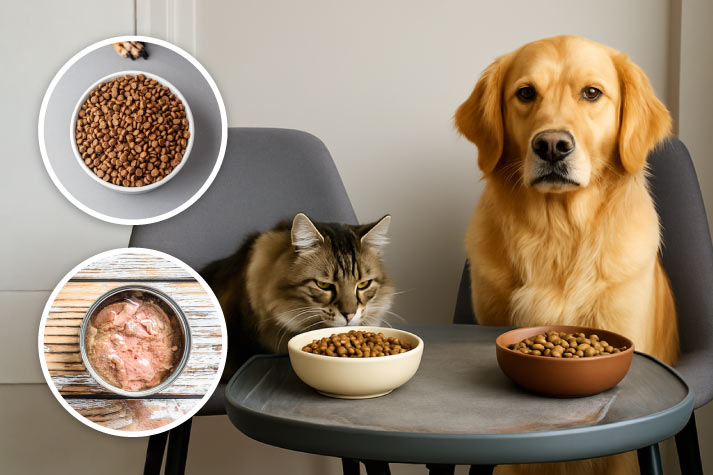


28 Aug
As pet parents, we are always looking for ways to keep our furry companions happy, healthy, and full of energy. Choosing the right pet food is one of the most important decisions we make because nutrition directly impacts pet health, behavior, and even lifespan. While many owners stick to either dry food or wet food, a growing number of veterinarians and nutrition experts recommend mixed feeding for dogs and cats, a thoughtful combination of both wet and dry food in daily meals.
Mixed feeding simply means combining wet food (canned or pouch meals) with dry kibble in a balanced way. Some pet owners offer a bowl of dry food in the morning and wet food in the evening, while others mix the two together in one meal. The idea is to bring together the best of both worlds, the convenience and dental benefits of kibble with the hydration and taste appeal of wet food.
This approach can be customized based on your pet’s age, breed, activity level, and health needs. For example, active dogs may need more calorie-dense kibble for energy, while senior cats might benefit from the extra hydration wet food provides.
Just like humans enjoy a diverse plate, pets benefit from variety in their diet. Dry food is typically calorie-rich and fortified with essential vitamins and minerals, while wet food often contains higher levels of protein and moisture. By combining them, you create a more nutritionally balanced meal plan.
For growing puppies, kittens, and even pets who travel frequently with their families, this variety can ensure they don’t miss out on critical nutrients. It also prevents mealtime from becoming boring, making pets look forward to their bowls every day.
Cats, in particular, are known for not drinking enough water on their own. Dogs may also forget to drink when they’re busy playing or traveling. Wet food contains about 70–80% moisture, compared to just 10% in kibble. When you include wet food in their diet, you’re giving your pets an easy way to stay hydrated without them realizing it.
Good hydration supports kidney function, digestion, and overall pet health, making mixed feeding especially beneficial in warmer climates or during long trips when water breaks may be less frequent.
Some pets are picky eaters, while others may face digestive issues with just one type of food. Wet food is generally easier to chew and digest, particularly for senior pets with dental challenges or young animals just learning to eat solid food. On the other hand, dry kibble supports healthy digestion with added fiber.
When combined, this wet and dry food combination for pets creates a meal that’s both satisfying and gentle on the stomach. Plus, the aroma and texture of wet food make meals more appealing, which can encourage pets with low appetite to eat better.
One of the main arguments for feeding kibble is its role in maintaining dental health. Crunching dry food helps reduce plaque and tartar buildup on teeth, which is vital for both dogs and cats. While wet food alone doesn’t provide this benefit, pairing it with dry kibble strikes a balance between oral care and overall nutrition.
For pet parents who want to avoid costly dental procedures later in life, mixed feeding is a simple step toward protecting their companions’ smiles.
For families who enjoy pet travel, mixed feeding offers flexibility. Dry kibble is convenient to carry and store, while wet food can be given as a special treat during trips to keep pets comfortable and hydrated. This combination ensures your dog or cat stays nourished even in unfamiliar environments, reducing stress during long journeys.
More and more pet owners are recognizing that feeding isn’t just about filling a bowl, it’s about nurturing long-term pet health. By adopting a wet and dry food combination for pets, they’re offering meals that balance nutrition, hydration, dental care, and taste. This trend also reflects a broader shift in how families view their dogs and cats: not just as pets, but as beloved companions deserving of the same care and variety in diet that we value for ourselves.
Mixed feeding for dogs and cats isn’t a passing fad; it’s a thoughtful approach to better nutrition and healthier lives. It combines the practicality of dry food with the richness and hydration of wet food, giving pets the best of both worlds. Whether you’re caring for a growing puppy, a finicky cat, or a senior companion, this feeding style adapts to their changing needs. From improved hydration to easier travel routines, the benefits go far beyond the food bowl.
As a pet parent, every choice you make impacts your companion’s happiness and well-being. By considering mixed feeding dogs and cats, you’re not just feeding them, you’re investing in their health, joy, and the countless memories you’ll share together.

AUTHOR’S BIO
Shivangi Lawania
Storytelling is my way of bringing ideas to life. I enjoy shaping words that spark curiosity and connection, while keeping a strong focus on branding and communication. For me, great content blends creativity with clarity to leave a lasting impression.